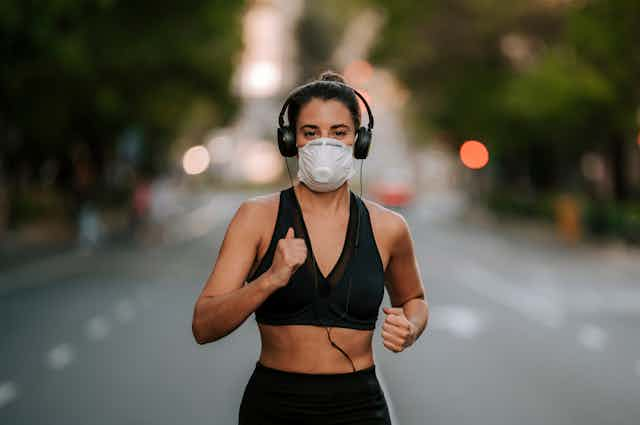The coronavirus began to affect sporting events as early as January 30, when the Chinese Football Association announced it was delaying the start of the football season. Two months later it was revealed that the Tokyo Olympic Games would be postponed until the summer of 2021 – the first postponement in modern Olympic history.
Sporting administrators are only now exploring ways to enable a return to training and competition at both professional and amateur levels. In the absence of a vaccine, though, there are several challenges. One of them is around breathing.
When playing sport, breathing is faster and harder than at rest, which increases the risk of passing the disease on. As a result, premier league football is considering introducing face masks. Others may follow suit.
Yet a mask makes it harder to inhale the quantity of air needed to perform at the highest levels. We know that wearing a surgical mask can increase the resistance to airflow. Exercise invariably leads to faster and harder breaths, so wearing a mask during exercise places a further strain on airflow.
At low to moderate-intensity exercise, effort will feel slightly harder than normal with a mask, but you can still walk comfortably. The challenge appears to be more during heavy exercise (say, rugby or football) taking in air at rates of about 40-100 litres per minute.
When we do heavy exercise, our muscles produce lactic acid, which causes that burning sensation. It is then converted to carbon dioxide and exhaled. But what happens if the carbon dioxide is trapped by the mask? As you move from moderate to heavy exercise, you may be re-breathing carbon dioxide, which can reduce cognitive function and increase breathing rate.
There may also be less oxygen in the recycled air, which could imitate exercising at higher altitudes. So it is important we gain a better understanding of the limitations of heavy exercise with a face mask.
The need for this understanding is growing, given the story reported on an Australian News Channel of two teenage boys in China dying within a week of each other during compulsory physical education examinations while wearing face masks. Autopsies have not been performed, so it’s impossible to know whether the masks played a role in the boys’ deaths. But it raises the question, is it safe to exercise with a face mask on during COVID-19?
A supplier of fencing equipment approached the University of Hertfordshire with just this question.
Treadmill test
To gain a rough understanding of the problem, I experimented on myself. I ran on a treadmill at 10kph for three minutes to reflect the intensity and duration of fencing. I did this with full fencing kit, with and without a cloth face mask under my fencing mask. I used a portable gas analyser and adapted it to measure the concentration of gases being breathed in and out.

The concentration of oxygen in the atmosphere is around 21% at sea level. When running on the treadmill with only the fencing mask, the concentration of oxygen was around 19.5%. This would be equivalent to exercising at 600m above sea level.
But wearing a face mask under the fencing mask reduced my oxygen level to around 17% – the equivalent of exercising at 1,500m. Any further decreases in oxygen concentration – by exercising longer or harder – would have a large effect on the physiological responses to exercise, causing altitude-sickness symptoms such as dizziness or headache.
There are negligible levels of carbon dioxide in atmospheric air, and when exercising with only the fencing mask this remains below 1%. With the face mask on, it trebled to 3%. Bear in mind that the UK Health and Safety Executive – the government agency responsible for regulation and enforcement of workplace safety – advises that employees should not be exposed to 1.5% carbon dioxide for more than 15 minutes.
Fencing has been part of the Olympics since 1896 and is unique in that we already have a mask on when exercising. So, before any recommendations are made for wearing a face mask for fencing, it is important that further research is undertaken on more than one person to explore the high carbon dioxide levels and low oxygen levels. There could be similar issues of wearing a face mask with other high-intensity sports.
With gyms looking to reopen and sports clubs wanting to resume, before anyone recommends wearing a face mask, research urgently needs to be undertaken to ensure the safety of the sporting community, regardless of any underlying conditions.

